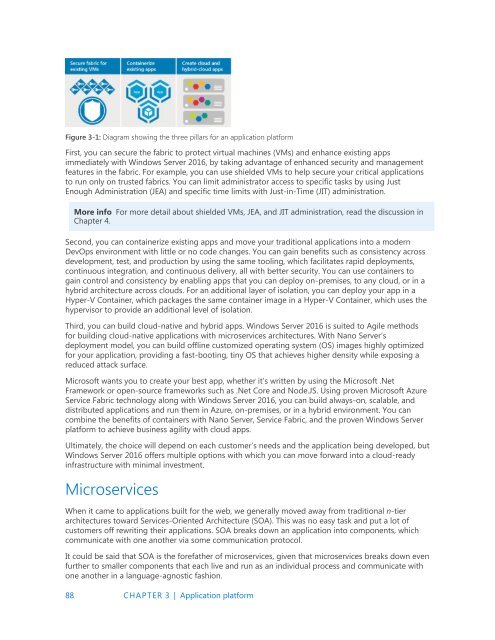Introducing
IntroducingWindowsServer2016_ebook
IntroducingWindowsServer2016_ebook
Create successful ePaper yourself
Turn your PDF publications into a flip-book with our unique Google optimized e-Paper software.
Figure 3-1: Diagram showing the three pillars for an application platform<br />
First, you can secure the fabric to protect virtual machines (VMs) and enhance existing apps<br />
immediately with Windows Server 2016, by taking advantage of enhanced security and management<br />
features in the fabric. For example, you can use shielded VMs to help secure your critical applications<br />
to run only on trusted fabrics. You can limit administrator access to specific tasks by using Just<br />
Enough Administration (JEA) and specific time limits with Just-in-Time (JIT) administration.<br />
More info For more detail about shielded VMs, JEA, and JIT administration, read the discussion in<br />
Chapter 4.<br />
Second, you can containerize existing apps and move your traditional applications into a modern<br />
DevOps environment with little or no code changes. You can gain benefits such as consistency across<br />
development, test, and production by using the same tooling, which facilitates rapid deployments,<br />
continuous integration, and continuous delivery, all with better security. You can use containers to<br />
gain control and consistency by enabling apps that you can deploy on-premises, to any cloud, or in a<br />
hybrid architecture across clouds. For an additional layer of isolation, you can deploy your app in a<br />
Hyper-V Container, which packages the same container image in a Hyper-V Container, which uses the<br />
hypervisor to provide an additional level of isolation.<br />
Third, you can build cloud-native and hybrid apps. Windows Server 2016 is suited to Agile methods<br />
for building cloud-native applications with microservices architectures. With Nano Server’s<br />
deployment model, you can build offline customized operating system (OS) images highly optimized<br />
for your application, providing a fast-booting, tiny OS that achieves higher density while exposing a<br />
reduced attack surface.<br />
Microsoft wants you to create your best app, whether it’s written by using the Microsoft .Net<br />
Framework or open-source frameworks such as .Net Core and Node.JS. Using proven Microsoft Azure<br />
Service Fabric technology along with Windows Server 2016, you can build always-on, scalable, and<br />
distributed applications and run them in Azure, on-premises, or in a hybrid environment. You can<br />
combine the benefits of containers with Nano Server, Service Fabric, and the proven Windows Server<br />
platform to achieve business agility with cloud apps.<br />
Ultimately, the choice will depend on each customer’s needs and the application being developed, but<br />
Windows Server 2016 offers multiple options with which you can move forward into a cloud-ready<br />
infrastructure with minimal investment.<br />
Microservices<br />
When it came to applications built for the web, we generally moved away from traditional n-tier<br />
architectures toward Services-Oriented Architecture (SOA). This was no easy task and put a lot of<br />
customers off rewriting their applications. SOA breaks down an application into components, which<br />
communicate with one another via some communication protocol.<br />
It could be said that SOA is the forefather of microservices, given that microservices breaks down even<br />
further to smaller components that each live and run as an individual process and communicate with<br />
one another in a language-agnostic fashion.<br />
88 CHAPTER 3 | Application platform


